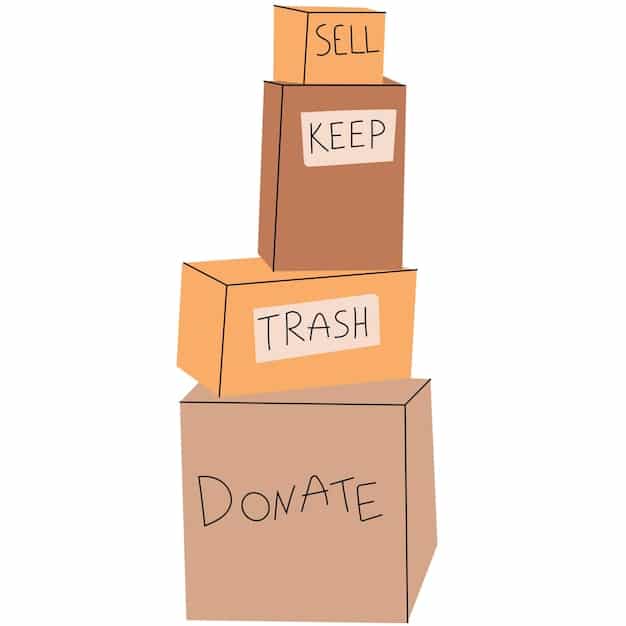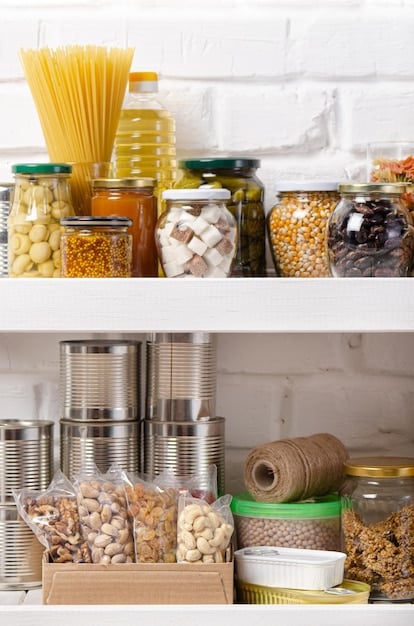Declutter Your Home in 30 Days: Room-by-Room Guide

Advertisements
Decluttering your home in 30 days can be achieved with a room-by-room approach, focusing on strategies for efficient organization, waste removal, and creating a more comfortable and functional living space.
Is your home feeling cluttered and chaotic? Do you dream of a serene, organized living space but feel overwhelmed by the task? Our declutter your home in 30 days guide offers a practical, room-by-room approach to transform your house into a haven.
Advertisements
Embark on a 30-Day Decluttering Journey
Embarking on a decluttering journey can seem daunting, but breaking it down into manageable daily tasks makes the process less overwhelming. Whether it’s tossing out old clothes or organizing kitchen cupboards, each step contributes to creating a more organized and serene home environment. Focusing on one room at a time will not only result in decluttered living spaces, but will also provide instant gratification and motivation to keep going.
This 30-day challenge is designed to provide a structured and sustainable approach to decluttering. Let’s explore how you can dramatically improve your living space, room by room, in just one month.
Advertisements
Preparation and Planning for Decluttering
Before diving into the decluttering process, it’s essential to prepare and plan effectively. This stage sets the foundation for a successful and stress-free experience. Having a clear strategy and mindset can make the entire journey smoother and more rewarding. Make sure you have a method to your madness by implementing a few guidelines from experts.
Set Clear Goals
Define what you want to achieve with your decluttering project. Are you aiming for a minimalist lifestyle, or simply seeking a more organized and functional home? Once you know what you want that end result to be, you are more likely to get closer to the goal.
Gather Essential Supplies
Having the right supplies on hand will streamline the decluttering process. These can include boxes for sorting items, trash bags for immediate disposal, cleaning supplies, and organizational tools. Grab your favorite cleaner and some rags so you can kill two birds with one stone!

- Boxes and Bags: Use sturdy boxes and trash bags for easy sorting of items.
- Cleaning Supplies: Have your favorite cleaning products ready for quick clean-ups.
- Organizational Tools: Baskets, bins, and drawer dividers can help with long-term organization.
By setting clear goals and gathering essential supplies, you’ll be well-prepared to tackle each room with efficiency and purpose. This initial planning phase is crucial for maintaining momentum and achieving the desired results.
Week 1: Conquer the Living Room
The living room is often the heart of the home, but it can quickly become a catch-all for clutter. This week, focus on transforming your living room into a welcoming and organized space. By decluttering a single room a week for the month, you are sure to have your house looking better in no time. Plus, you won’t be as overwhelmed.
Start by removing any items that don’t belong in the living room. Then, tackle individual areas such as the coffee table, bookshelves, and entertainment center.
Declutter the Coffee Table
Clear off stacks of magazines, remote controls, and other miscellaneous items. Keep only essential items on the coffee table and store the rest in drawers or baskets.
Organize Bookshelves
Remove books you no longer read or need. Organize the remaining books by genre, color, or size for a visually appealing and functional display.
- Sort Books: Remove any books you no longer need or enjoy.
- Organize Decor: Arrange decorative items to create a balanced and appealing display.
- Dust and Clean: Give the shelves a thorough cleaning.
By the end of week one, you should have a more spacious and inviting living room. Remember to maintain your progress by putting items back in their designated places after each use.
Week 2: Dominate the Kitchen
The kitchen is another high-traffic area that can quickly accumulate clutter. This week, focus on decluttering your kitchen by targeting cabinets, pantries, and countertops. All of these areas are essential in improving your kitchen as a whole. As you declutter, think of functionality too so you can have the most optimal kitchen space for yourself.
Begin by removing expired food items and unused kitchen gadgets. Then, organize your cabinets and drawers to make cooking and meal preparation more efficient.
Clean Out the Pantry
Remove expired or stale food items. Organize remaining items by category and use clear containers to keep things visible and easily accessible.
Declutter Kitchen Cabinets
Get rid of unused pots, pans, and dishes. Organize remaining items so that frequently used items are within easy reach.

- Discard Expired Items: Check expiration dates and toss out any outdated food.
- Organize by Category: Group similar items together for easy access.
- Use Clear Containers: Store food in clear containers to see what you have at a glance.
A well-organized kitchen will make cooking and cleaning much more enjoyable. By the end of week two, you’ll have a more functional and efficient kitchen space.
Week 3: Tidy Up the Bedroom
The bedroom should be a sanctuary for rest and relaxation. This week, focus on decluttering your bedroom by organizing your closet, dresser, and bedside tables. These areas are essential to creating a relaxing space for the end of the day and to get ready in the morning.
Start by sorting through your clothing and accessories. Then, declutter your bedside tables and create a relaxing atmosphere for sleep.
Sort Through Clothing
Remove clothes you no longer wear or that don’t fit. Donate or sell items in good condition and discard anything damaged or unusable.
Organize Dresser Drawers
Fold or roll your clothes to maximize space. Use drawer dividers to keep items organized and easily accessible.
- Remove Unworn Items: Donate or sell clothes you no longer wear.
- Organize Accessories: Neatly store jewelry, scarves, and belts.
- Create a Relaxing Atmosphere: Clear clutter from bedside tables and add calming decor.
A clutter-free bedroom promotes better sleep and a more peaceful mindset. By the end of week three, your bedroom should be a tranquil and organized retreat.
Week 4: Streamline the Bathroom
The bathroom, though small, can easily become cluttered with toiletries, cleaning supplies, and other miscellaneous items. This final week, concentrate on decluttering your bathroom to create a clean and organized space. This is especially important because bathrooms are often humid, so excess items can be a breeding ground for bacteria if items aren’t cleaned out routinely.
Begin by removing expired or unused toiletries. Then, organize your vanity drawers and cabinets to maximize space and efficiency.
Declutter Toiletries
Remove expired makeup, skincare products, and other toiletries. Consolidate duplicates and discard anything you no longer use.
Organize Vanity Drawers and Cabinets
Use drawer dividers and organizers to keep items neatly arranged. Store frequently used items within easy reach.
- Remove Expired Items: Check expiration dates on all products.
- Consolidate Duplicates: Combine similar items to save space.
- Maximize Storage: Utilize vertical space with shelves and organizers.
A well-organized bathroom makes your daily routine smoother and more enjoyable. By the end of week four, your bathroom should be a clean, functional, and clutter-free space.
Maintaining Your Decluttered Home
Once you’ve completed your 30-day decluttering challenge, it’s essential to establish habits that will help you maintain your newly organized home. Regular maintenance will prevent clutter from accumulating again and keep your living spaces comfortable and functional.
Schedule short decluttering sessions each week to prevent clutter from building up. Practice the one-in-one-out rule to avoid bringing unnecessary items into your home. Don’t let the home get so cluttered that it requires a whole month to fix again.
Regular Decluttering Sessions
Dedicate 15-30 minutes each week to decluttering specific areas of your home. This will help you stay on top of clutter before it becomes overwhelming. Set a timer on your phone to make sure you are being efficient during this time.
Practice the One-In-One-Out Rule
For every new item you bring into your home, get rid of a similar item. This will help you avoid accumulating excess belongings.
By implementing these maintenance strategies, you can enjoy a perpetually organized and serene home environment. Consistency is key to sustaining the benefits of your decluttering efforts.
| Key Point | Brief Description |
|---|---|
| 🏠 Room Focus | Tackle one room per week for efficient progress. |
| 🗑️ Declutter Supplies | Boxes, bags, and cleaners are essential for sorting. |
| ⏰ Maintenance | Regular sessions prevent clutter buildup. |
| ♻️ One-In-One-Out | Remove an old item when bringing in something new. |
Frequently Asked Questions
▼
Start with a small, manageable area like a single drawer or shelf. This can give you a quick win and momentum to tackle larger projects. Starting small can also keep you from getting overwhelmed, and give you the encouragement you need.
▼
Create a designated box for sentimental items. If the box gets full, revisit the items and make choices. Take pictures of items you can’t part with to preserve the memories without the clutter. Make sure that box stays organized too.
▼
Sort items into categories: donate, sell, recycle, or trash. Donate usable items to local charities, sell valuable items online or at consignment shops, recycle what you can, and dispose of unusable items responsibly. There may even be some local services to help.
▼
Aim for a quick decluttering session once a week and a more thorough decluttering session every few months. Regular maintenance prevents clutter from accumulating and keeps your home organized. Depending on your home size, there may be other factors.
▼
Establish habits like putting items back in their place immediately and practicing the “one-in-one-out” rule. Regularly reassess your belongings and declutter as needed to maintain a clutter-free environment. A simple routine should be enough for most.
Conclusion
Transforming your home with our declutter your home in 30 days guide is a worthwhile endeavor. By following this room-by-room approach, you can create a more functional and serene living space, enhancing your overall quality of life. Remember, maintaining a clutter-free environment is a continuous process that promotes peace and well-being.